Topping this year’s list is prime minister Fredrik Reinfeldt, followed by finance minister Anders Borg.
The third most powerful person in Sweden, according to Fokus, is newly installed Centre Party leader Annie Lööf, whose appointment ratcheted her up from 62nd place last year to make her the country’s most powerful woman.
”One of the aims of publishing this list is to initiate a debate on ‘what is power?’, said Torbjörn Nilsson, political editor of Fokus Magazine to The Local.
Reading through the list, however, there are very few non-Swedish sounding names, and none from the top 100 are foreigners who have arrived in the country as an adult.
While Left Party MP Rosanna Dinamarca who occupies place 100, was born in Chile, she came to Sweden as a young child.
In addition, Angeles Bermudez-Svankvist, head of the National Employment Agency (Arbetsförmedlingen) was born in Mallorca, but has a Swedish mother and has lived in Sweden since she was a teenager.
Fokus’s Nilsson offered up a couple of explanations as to why the magazine’s list lacked foreigners.
”There are two possibilities, either there is something wrong with our system, which we don’t claim to be in any way scientific, or it is in fact a reflection of what Sweden looks like,” said Nilsson.
”I would say, although I can’t prove it in any way, that there are few people with a foreign background who hold these positions in Sweden,” he added.
In order to come up with the ranking, 300 names are initially selected, slimmed down to 200, after which they are reviewed by a panel of experts on Swedish politics and business.
After that, the 200 are graded on criteria such as media exposure, formal power, informal power, and extraordinary power. Finally, the 100 with the highest score are selected for the list.
One aspect that the selection committee did find surprising this year, was that the number of newcomers on the list was almost as high as last year.
In 2010, an election year, 43 new names entered the list.
Somewhat surprisingly, this year, the major changes within the Swedish political parties meant that a further 40 newcomers entered the top 100 most powerful people in Sweden.
Despite this, Reinfeldt and Borg nabbed the top two spots for the third year running.
And the 28-year-old Lööf, who is also minister for enterprise, kicked last year’s number three, minister for education Jan Björklund, off his spot, while at the same time claiming her title as Sweden’s most powerful woman.
”That Annie Lööf went straight in to spot number three was surprising to us, and she made that spot to a large degree because of the exposure in the media,” Nilsson said.
The second most powerful woman, also managing to squeeze into the top ten, is EU minister Birgitta Olsson.
The head of the Riksbank, Stefan Ingves, was the only non-politician within the top ten most powerful people in Sweden.
Crown princess Victoria lost her place at 17 in 2010 to place 29 this year, also attributed to less media coverage compared to last year.
The Royal wedding in 2010 meant a huge rise in media coverage for the crown princess, which this year’s pregnancy revelation didn’t quite manage to live up to.
In total, 29 out of the 100 most powerful people in Sweden in 2011 are women, one more than last year.



 Please whitelist us to continue reading.
Please whitelist us to continue reading.
Member comments